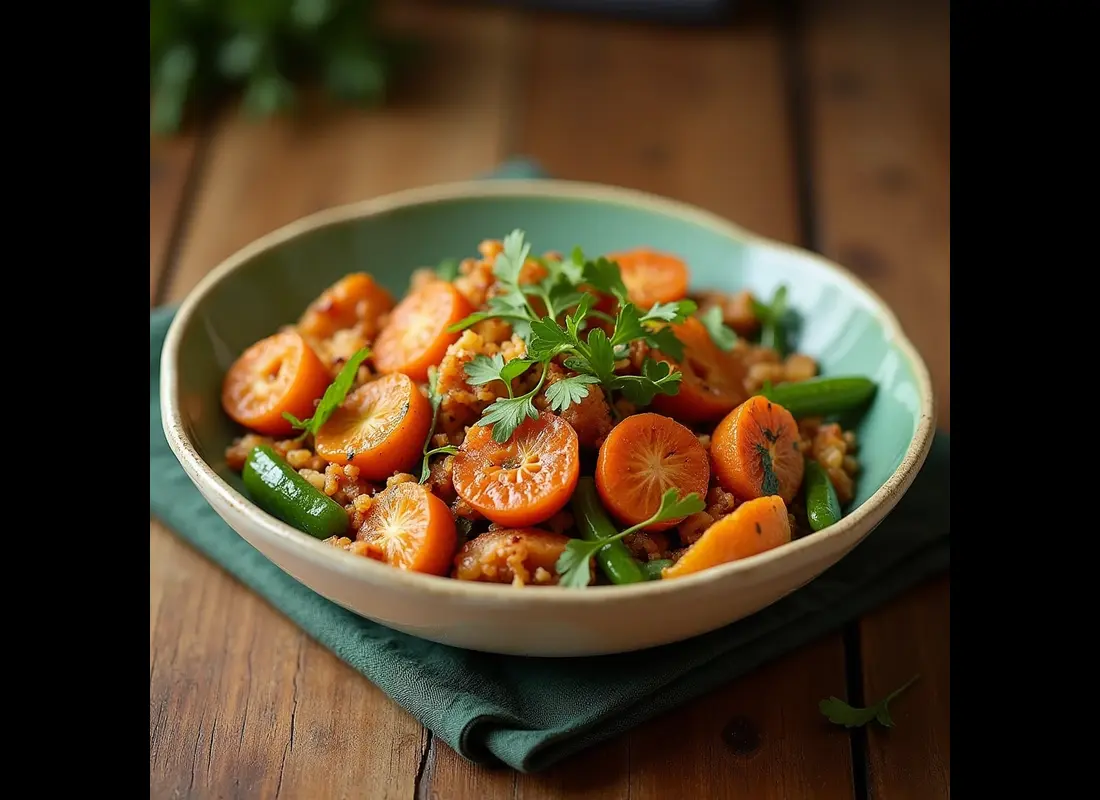Introduction
Thai cuisine enthusiasts love drunken noodles, or Pad Kee Mao, for their bold, spicy flavors and the aromatic blend of holy basil, garlic, and fresh chilies.
This iconic stir-fried noodle dish, made with chewy broad rice noodles, is a staple of Thailand’s street food culture. However, the term “Kee Mao” often creates confusion. Some believe it refers to a separate dish, while others recognize it as simply another name for drunken noodles.Understanding the relationship between drunken noodles and Kee Mao is essential for appreciating the nuances of Thai cuisine. Are they two distinct dishes, or are they identical but referred to differently in various contexts? By exploring their origins, ingredients, and regional interpretations, we can uncover how this flavorful dish reflects Thailand’s rich culinary heritage and its adaptability across cultures. This article aims to clarify the mystery and celebrate their shared appeal.
What Are Drunken Noodles?
People enjoy drunken noodles, or Pad Kee Mao, as a popular Thai stir-fried noodle dish with a bold, spicy, and savory flavor profile.
They feature wide rice noodles, which provide a chewy texture that soaks up the dish’s robust sauces and seasonings. The combination of fresh chilies, garlic, and holy basil gives the dish its signature heat and aromatic depth, while the umami flavors come from a blend of soy sauce, fish sauce, and sometimes oyster sauce.Chefs often complement the dish with a variety of vegetables, such as bell peppers, onions, and baby corn, which makes it visually appealing and nutritionally balanced.
Proteins like chicken, shrimp, tofu, or even pork add heartiness to the dish, catering to a wide range of dietary preferences.Drunken noodles are a quintessential part of Thailand’s street food culture, offering a quick, flavorful meal that appeals to locals and tourists alike. Despite their intriguing name, the dish contains no alcohol. Instead, theories suggest the name originates from its popularity as a late-night comfort food or hangover remedy, pairing well with an ice-cold beer.
In Thai cuisine, Pad Kee Mao represents the perfect balance of bold flavors, quick preparation, and versatility.
The dish adapts easily to different ingredients and spice levels. This makes it a favorite for diners seeking a fiery, satisfying meal that reflects Thailand’s culinary traditions.
What Is Kee Mao?
The term “Kee Mao” originates from Thai and translates to “drunkard.” People often associate it with the popular dish drunken noodles (Pad Kee Mao), leading to much of the confusion. In Thai cuisine, “Kee Mao” is not a standalone dish but a descriptor frequently applied to drunken noodles, emphasizing their bold, spicy flavors and reputation as a hangover cure or late-night indulgence.
The name “Kee Mao” reflects the dish’s origins and cultural context. Some theories suggest that the fiery combination of chilies, garlic, and holy basil invigorates dulled senses. This makes the dish popular among those recovering from a night of drinking. Others believe the name refers to its improvisational nature, using whatever ingredients were on hand after a drinking session.
In Thailand, people recognize Pad Kee Mao as a staple of street food culture, with the term “Kee Mao” being synonymous with drunken noodles. In Western countries, however, diners often misunderstand the name “Kee Mao” or interpret it as a separate dish.
This confusion often arises from translations or menu presentations that differentiate between the terms.Ultimately, “Kee Mao” serves as a colorful descriptor highlighting the dish’s spicy, lively character. Whether referred to as drunken noodles or Pad Kee Mao, it remains the same flavorful dish that captures the essence of Thai culinary tradition and street food vibrancy.
Flavor and Ingredient Profiles
Drunken Noodles
Drunken noodles, or Pad Kee Mao, are celebrated for their spicy, bold, and herbaceous flavors. The dish combines the heat of fresh chilies with the aromatic, peppery taste of holy basil, creating a vibrant and flavorful experience. The noodles are typically wide rice noodles, known for their chewy texture and ability to absorb the rich sauces. The base of the sauce includes soy sauce, fish sauce, and sometimes oyster sauce, contributing to the dish’s savory umami profile.
Vegetables such as bell peppers, onions, and sometimes baby corn add a fresh, crunchy contrast to the noodles. The dish is completed with a protein of choice, such as chicken, shrimp, tofu, or pork, making it versatile and hearty.
Kee Mao
The term Kee Mao refers to the same dish as drunken noodles, with no significant difference in its core ingredients or preparation. However, regional or personal adaptations may lead to slight variations. For instance, some cooks may add tomatoes for a tangy note or use different vegetables based on availability. Fusion versions of Kee Mao have also emerged, using alternative noodles like spaghetti or zucchini noodles, especially in Western interpretations. These adaptations cater to local preferences while maintaining the dish’s characteristic flavors.
Commonalities
Both drunken noodles and Kee Mao rely on soy sauce, fish sauce, and holy basil for their distinctive flavor. Fresh chilies and garlic provide heat and aroma, while the combination of sauces ensures a balance of salty and umami tastes. Both dishes offer flexibility with vegetables and proteins, making them adaptable to different diets and preferences.
Whether called drunken noodles or Kee Mao, this dish consistently delivers a satisfying, flavor-packed meal that showcases the vibrant, spicy essence of Thai cuisine. The versatility in preparation and presentation makes it a favorite across cultures and culinary traditions.
The Misconception Around Kee Mao
The term Kee Mao, which translates to “drunkard” in Thai, has become synonymous with drunken noodles due to its use as a descriptor for the dish. In Thailand, locals widely recognize Pad Kee Mao as the official name for drunken noodles. The dish’s reputation for being spicy, bold, and flavorful is thought to make it a popular choice for late-night diners or those recovering from a night of drinking. This association with “drunkards” led to its colloquial name, even though the dish contains no alcohol.
For Thai locals, Kee Mao is not a standalone term but rather a reference to the characteristics of the dish. The concept of Kee Mao is deeply rooted in the vibrant street food culture of Thailand, where such dishes are enjoyed for their intense flavors and comforting appeal.
However, among international diners, the name “Kee Mao” is often misunderstood. In some cases, it is perceived as a separate dish or a variation of drunken noodles due to menu translations or misinterpretations. Additionally, regional adaptations in Western countries, such as the use of alternative noodles or vegetables, may add to the confusion.
Ultimately, Kee Mao and drunken noodles refer to the same dish, but cultural and linguistic nuances have created differing perceptions. Understanding this context helps diners appreciate the dish’s origins and its role in Thai culinary traditions.
Regional Variations of Drunken Noodles (Kee Mao)
Drunken noodles (Pad Kee Mao) have gained worldwide popularity, leading to various adaptations that reflect local tastes and ingredient availability. In the United States, the dish is often tailored to appeal to a broader audience. Spice levels are frequently reduced, and the inclusion of extra vegetables like broccoli or carrots caters to American preferences for more balanced meals. Additionally, fusion versions using spaghetti or linguine have become popular, combining the bold flavors of Thai cuisine with Western pasta.
In Europe, the dish is similarly adjusted to suit milder palates. European versions often emphasize less spice and may incorporate local vegetables such as zucchini or mushrooms. Restaurants might use less traditional proteins like beef or salmon, depending on regional availability and tastes.
Across Asia, drunken noodles maintain their authenticity but can still vary by country.
Cooks in Malaysia or Singapore often add local spices or sauces to give the dish a unique twist while retaining its core Thai identity.
Fusion adaptations have also made the dish more accessible to those with dietary restrictions. Gluten-free noodles made from quinoa or rice flour are now common in Western interpretations, allowing people with gluten sensitivities to enjoy the dish. For health-conscious diners, lighter versions with reduced oil or sodium are becoming increasingly popular.
Globally, presentation and preparation styles differ as well.
In Thailand, vendors serve traditional drunken noodles in a casual, street-food style. Upscale restaurants in the West, however, often garnish the dish with microgreens or present it in elegant bowls, showcasing its versatility.
These adaptations ensure the dish remains a favorite across cultures.Health and Nutritional Comparison of Drunken Noodles (Kee Mao)
Drunken noodles (Pad Kee Mao) are flavorful but can be calorie-dense due to their ingredients and preparation. A standard serving typically contains around 400–600 calories, depending on portion size and protein choices. The wide rice noodles contribute to the dish’s carbohydrate content, providing quick energy but often lacking fiber. The sauces, made from soy sauce, fish sauce, and sometimes oyster sauce, add rich umami flavors but also high levels of sodium, which can exceed daily recommendations if portions are large.
Homemade versions of drunken noodles offer more control over nutritional content compared to restaurant adaptations. At home, you can reduce the amount of oil used for stir-frying and choose low-sodium alternatives for sauces. Additionally, homemade recipes allow you to add more vegetables like broccoli, bell peppers, and snap peas, boosting the dish’s fiber and vitamin content. Lean proteins like chicken breast or tofu can replace higher-fat cuts of meat.
In contrast, restaurant versions often use more oil and sodium to enhance flavor, increasing calorie and sodium content. Portions are usually larger, leading to higher overall calorie intake.
Healthier preparation techniques include stir-frying with minimal oil in a non-stick pan, using whole-grain noodles or spiralized vegetable noodles for added fiber, and creating homemade sauces to control sodium levels. Adding extra vegetables not only increases nutrients but also reduces the dish’s calorie density. These changes make drunken noodles a healthier option without compromising their signature bold and spicy flavors.
FAQs Section
Are drunken noodles and Kee Mao the same?
Yes, drunken noodles and Kee Mao refer to the same dish. Kee Mao, which translates to “drunkard” in Thai, is the traditional name for drunken noodles.
People often use the terms interchangeably, but cultural and regional differences sometimes lead to confusion.
Why are they called drunken noodles?
Despite the name, drunken noodles contain no alcohol.
Theories suggest the name originates from the dish’s bold, spicy flavors, which many believe awaken dulled senses and make it a popular choice after a night of drinking. Others think it pairs well with beer or that someone first improvised it using leftover ingredients after a drinking session.
Can drunken noodles be made less spicy?
Yes, you can easily adjust the spice level of drunken noodles. Reduce the amount of fresh chilies or use milder chili varieties. You can also balance the heat by adding a touch of sweetness with sugar or honey to soften the spiciness without compromising the dish’s flavor.
Conclusion
Drunken noodles (Pad Kee Mao) and Kee Mao are two names for the same iconic Thai dish. This dish is known for its bold, spicy, and savory flavors.
While there is no fundamental difference between the two, Kee Mao serves as a traditional descriptor rooted in Thai culture. Both terms highlight the vibrant, spicy, and aromatic profile of this beloved stir-fried noodle dish.The key to appreciating this dish lies in understanding its versatility and adaptability.
You can enjoy it with a fiery kick or a milder spice level. Whether made with traditional rice noodles or fusion alternatives, it remains deeply satisfying.
The combination of wide noodles, fresh vegetables, and proteins ensures every bite is rich in flavor and texture.To truly appreciate the magic of drunken noodles, try different variations at restaurants or experiment with homemade recipes. Each interpretation offers a unique take on this Thai classic, allowing you to savor its delicious and versatile essence.

